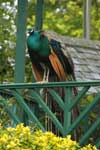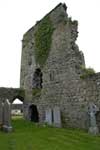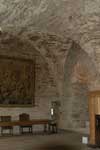
Travelogue
Photos
Today
Ardcroney Castle
Nenagh Castle
Rural Housing
Ballycapple Castle
Cloughjordan Castle
Ballymackey Castle
St Cronans
Roscrea Castle
Black Mill
Leap Castle
Ser Keiren
Kinnitty Castle
ieland
Travelogue, Day 18
Our B&B last night (Ashley Park House) was very comfortable, if a bit derelict. It's an old Georgian house with lovely grounds, a couple of peacocks, enormous rooms, and antique furniture. We had an antique brass bed. Everything is a little shabby and needs a coat of paint and some minor repairs -- the stairs in particular are a little dicey. Having owned a relatively old house myself, I can only imagine the level of maintenance that these even older houses require on a daily basis. Especially in a wet climate, wood and stone need constant care. Get even a little behind and it's a race to catch up with the destructive power of rain.
 We were forgotten a bit at breakfast -- a communication issue between the night staff who knew we were here and the day staff who didn't -- but we had a quiet night in a comfortable bed and the curtains were dark. What more can I ask?
We were forgotten a bit at breakfast -- a communication issue between the night staff who knew we were here and the day staff who didn't -- but we had a quiet night in a comfortable bed and the curtains were dark. What more can I ask?
We did get into a discussion at breakfast as we sipped coffee and orange juice and waited for eggs about the way food labels are different here (I'm not sure if it's in Ireland specifically or in Europe..or, well, everywhere that is not the US). Here, everything is labeled in terms of 'calories and nutrients per 100 grams'. No mention whatsoever of the actual side of a server, or how much of whatever food equals 100 grams. The yogurt at breakfast, for example, was 125 grams, but all the nutrition information was for 100 grams. Why? Why not just give it for the whole package for foods that you are going to eat "one" of? No one is going to eat 4/5ths of the yogurt, so now they have to do math, at a time in the morning when their coffee or tea have not kicked in yet. It's bizarre to me - a slice of bread, a container of jam, a candy bar--all of these things are eaten "whole". Why on earth is nutritional info not provided for that logical amount?
Mark's argument that it makes it easier to compare one foodstuff to another does carry some water, I guess. But I content that only works if people are weighing their food to determine how much peanut butter they can eat vs popcorn. Most people probably don't have any idea about the "serving size" amount. That often makes a big difference.
I just think that there are some foods that should be counted and labeled as "whole". Eggs. Slices of bread. Apples. If you normally eat one of them, then that seems to be a logical way to label things. Otherwise, I have to do some non-trivial calculation to figure it out. "If the whole loaf is 900 grams and there are 13 slices of bread in the loaf, so the one slice is 77 grams and if its 143 calories per 100 grams then what's 77/143…" Mark insists that makes more sense, but I stand by my assertion that it is just confusing.
(Ok, I should admit that I don't really pay much attention to the labels anyway, this was all an academic exercise while we sat with our juice.)
Roaming the misty countryside
 It started out misty and rainy (well, we had to pay for al the sunshine sometime, I guess) so we got a bit of a later start before we stopped at Ardcroney castle and then popped back into Nenagh to check out the round tower house (very strange, I don't think I saw another round tower house the rest of the trip). According to the GPS we've traveled about 1800 km at an average speed of less than 40 kpm. Ooh. Speed demons. Admittedly, we didn't have the thing on all the time, so it is most likely a rather skewed calculation based on our searching for a specific location and stopping every four seconds.
It started out misty and rainy (well, we had to pay for al the sunshine sometime, I guess) so we got a bit of a later start before we stopped at Ardcroney castle and then popped back into Nenagh to check out the round tower house (very strange, I don't think I saw another round tower house the rest of the trip). According to the GPS we've traveled about 1800 km at an average speed of less than 40 kpm. Ooh. Speed demons. Admittedly, we didn't have the thing on all the time, so it is most likely a rather skewed calculation based on our searching for a specific location and stopping every four seconds.
Which we did again today. We kept driving past little concrete bunkers and finally came to the conclusion that they are public water pumps. Tall hand-pumps with a concrete surround, by the side of the road every few miles. They appear to be painted in interesting patterns, but we can't figure out exactly what they are intended for, or for that matter, how they are maintained. The don't look like private irrigation pumps or anything (and why would they be necessary in rainy Ireland?). We counted five or six of them along the road.
Nenagh has a little heritage center museum that is housed in the original town jail - an octagonal building that looks like a water tower more than any sort of public building. It was an interesting little museum, and it kept us out of the rain for a while. I really like the local museums -- most of them are a few rooms of random objects that have some relationship to the local house, farm, or village. Farm tools, pots and pans, stray shoes, letters, that sort of thing. If you're lucky, there's a docent around who knows everything there is to know about the town you're in and you get a quick history lesson and some interesting gossip. Well, you also run the risk of being cornered by the town know-it-all, too, but that's true everywhere!
We found the castles in Ballycapple and Cloughjordan almost by accident as we drove around in ever-widening circles from Nenagh. Cloughjordan is in the side-yard of a cottage and just a bit down from there was a house with scary electrical service -- the electric wires when to a lone wall of an otherwise destroyed cottage in the yard. We couldn't quite figure that one out. Ballymackey Castle just appeared as if like magic - we rarely find things that easily!
Rows of little houses, all the same
There is so much building going on in Ireland that it's rare to drive any stretch of road and not see at least one house going up. Crews are everywhere. Most of the houses we're seeing are made of concrete block and stucco'd or pebbledashed, with "stone" steps around the doors and windows. We saw one house that was specifically advertised as "wood-frame-builder". It makes sense I guess. Cement block is just the stone of modern construction, and it's longer lasting than wood in this environment, I think. The second floor and roof are usually wood joists, the roof itself is nearly always tile or slate or fake-slate. That seems to be the case no matter what the "class" of housing being built -- executive homes or little bungalows, the types just seem to be a matter of size and location, not of style.
 A starter house here is quite small - about 1000 square feet, and terraced houses are more common here that I'm used to (terraced houses being roughly equal to town-houses or row-houses in the US). We can't quite figure out all the terms - bungalow, villa, estate house, detached, semi-detached. I think we figured out the detached and semi-detached (a single-family home and a duplex), and a villa is a larger version of a bungalow (both detached) that has a little bit of garden. Estates still abound, although many of them are being chopped up and sold to developers who are building "planned communities". One thing that really struck us is the homogeneity of these housing developments -- quite literally, the houses are exactly alike and can only be identified by house number. Same style, same color, same size, same tree out front. There are perhaps a dozen or so houses all the same on the street, and the next street over has a slightly different style of house, and further down is a cluster of yet another design. A development may have three or four house styles, but they don't seem to be mixed. I wonder if they have HOA (Home Owners Associations) that control the look-and-feel of the neighborhood,like many of ours do.
A starter house here is quite small - about 1000 square feet, and terraced houses are more common here that I'm used to (terraced houses being roughly equal to town-houses or row-houses in the US). We can't quite figure out all the terms - bungalow, villa, estate house, detached, semi-detached. I think we figured out the detached and semi-detached (a single-family home and a duplex), and a villa is a larger version of a bungalow (both detached) that has a little bit of garden. Estates still abound, although many of them are being chopped up and sold to developers who are building "planned communities". One thing that really struck us is the homogeneity of these housing developments -- quite literally, the houses are exactly alike and can only be identified by house number. Same style, same color, same size, same tree out front. There are perhaps a dozen or so houses all the same on the street, and the next street over has a slightly different style of house, and further down is a cluster of yet another design. A development may have three or four house styles, but they don't seem to be mixed. I wonder if they have HOA (Home Owners Associations) that control the look-and-feel of the neighborhood,like many of ours do.
No stopping modern progress
We saw a few tower houses today from the road, but couldn’t et near enough to even take good pictures. The road just doesn't seem to go there, as far as I can tell. I have to pay very close attention to the map as we drive (which can be a bit motion-sickness inducing if I'm not careful), so that I catch every single curve and turn and track the lefts and rights, just to keep track of us on the map. Otherwise, I get "lost" from where we are and where we end up going. When there are fifteen intersections in a square of map, it can be difficult to make sure you hit the right one.
We pulled over in St. Cronans just to look at a surprisingly modern-looking church there, but quickly moved on when everything was locked up.
It was pouring by the time we hit Roscrea, but we parked and walked around a bit to see the truncated round tower of St. Cronans on one side of the main road, and the façade of the church on the other side of the street, quite literally on the pavement. The main Limerick road goes right through the original site. The castle here is chopped up pretty badly. I got no outside pictures because of the pouring rain (I really should have bought a camera-baggie or something) but in the bawn is Damer House, an 18th century restored house with museum exhibitions. The castle itself is not restores, although it is in fairly good condition, probably because the English used the castle as a garrison for many years. The current "castle" is really the gatehouse, with three floors and an actual drawbridge. It's got a few interesting touches (including straw on he floor in the main entry) that make it an interesting exhibit. There isn't access to the roof, but you can climb up and see the finished rooms. The towers in the outer wall front to the street, and we didn't bother climbing them or going into the little shop.
 One of the buildings that is almost entirely restored and converted is an old Mill in town. The original floors and walls are in place, and it's being used as a gallery. All the metal braces and cables holding this building together over three floors are in place, and it's easy to imagine the roar and clank of machinery -- even though the space is empty right now.
One of the buildings that is almost entirely restored and converted is an old Mill in town. The original floors and walls are in place, and it's being used as a gallery. All the metal braces and cables holding this building together over three floors are in place, and it's easy to imagine the roar and clank of machinery -- even though the space is empty right now.
Instead, we dashed back to the car park and then to lunch. We popped into "The Tower" restaurant for lunch, which was recommended in several of our guides. We had to eat in the bar, though. The lunch menu ended at 3pm and walked in just at 3. But, burgers and chicken strips were on the menu and it was warm and cozy inside. Mark said his burger was more meatloaf-like than burger-like, but quite good. Surprisingly, the ketchup was Heinz brand, making the enormous serving of chips worthwhile! I had garlic sauce on my chicken strips and I'm sure I'm going to be fun conversational companion in the car for a few hours!
Stuffed with chips and an astoundingly large piece of pie, we squelched back to the car and drove on. Leap Castle appears to be inhabited -- the gates are open, but there are a bunch of cars and workmen there, so we didn't intrude. A few picture from the road, but that's it. Sier Ceiran is just down the road, and has a small round tower and the stub of a high cross -- probably interesting to someone who is fascinated by them, but otherwise not so exciting. My book says it is a monastic site, but if it was, it was teeny, weeny monastery. It did stop raining though.
Calling it a day
Kiniity Castle is a huge hotel -- and not really a castle, unless there is a ruin on the grounds that we didn't see. It's a huge victorian hunting-lodge sort of place and even though we had already found a B&B for the night, I had serious buyers remorse and wanted to stay here. I tend to do this, we pick someplace and suddenly I find a dozen other B&Bs to stay in. We bought the guidebooks for B&Bs and guesthouses from the tourist office on our first day in ireland and it's been indispensable. That and the cell phone made finding a place to crash for the night much easier. We drove away only reluctantly, since Kiniity is a "spa hotel" and I'm sure very pricey, but it sure looked pretty.
I wanted to go to Durrow Monastery to see the high cross there, but as we headed out traffic was actually a bit heavy. Given the unpredictability of travel times, we decided to head straight to the B&B since we promised to arrive by 6:30. It's been raining off and on all day, which sucked the life out of us and so we decided to call it an early night. I'm glad we set off directly, we barely made it.
The B&B is very "american" and recommended by the AA (four stars). IT's comfortable, the room is large and very spare, and the bathroom (while small) is definitely geared toward tourists. There are nine rooms here. And, cable tv. We picked a good place to crash early and just lump.